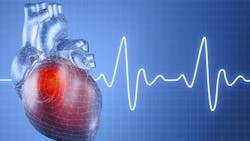Cardiac Arrest Survival Rates Higher with AED Use
An international group of researchers has discovered that those suffering from cardiac arrest in a public setting are twice as likely to survive if an automated external defibrillator (AED) was utilized before emergency help arrived.
The study, published in the American Heart Association’s journal Circulation, analyzed 49,555 out-of-hospital cardiac events in major U.S. and Canada cities.
“We estimate that about 1,700 lives are saved in the United States per year by bystanders using an AED,” said Myron Weisfeldt, M.D, senior study author, in a statement. “Unfortunately, not enough Americans know to look for AEDs in public locations, nor are they are trained on how to use them despite great and effective efforts of the American Heart Association.”
During a cardiac arrest, the electrical activity in the heart is disrupted. Without immediate CPR, the heart, brain and other vital organs aren’t receiving enough oxygenated blood. For every minute without CPR, the chance of death increases by 10 percent, according to the AHA.
Fewer than half (45.7 percent) of cardiac arrest victims get the immediate help they need before emergency responders arrive, in part because emergency medical services take, on average, between four and 10 minutes to reach someone in cardiac arrest, according to the AHA.
“Bystanders have the potential to save a life,” Weisfeldt said. “This should be a great incentive for public health officials and bystanders to strive to have AEDs used on all victims of cardiac arrest.”
Sixty-six percent of victims who received a shock from AED from a bystander survived to hospital discharge. The research stressed the critical difference in those who received cardiac care before responders arrived on the scene.
Researchers also discovered the following:
- Cardiac arrest victims who received a shock from a publicly-available AED that was administered by a bystander had 2.62 times higher odds of survival to hospital discharge and 2.73 times more favorable outcomes for functioning compared to victims who first received an AED shock after emergency responders arrived.
- Victims who received an AED shock from a bystander (57.1 percent) using a publicly-available device instead of having to wait for emergency responders (32.7 percent) had near normal function and better outcomes.
- Without a bystander using AED shock therapy, 70 percent of cardiac arrest patients either died or survived with impaired brain function.
- AHA officials used the study’s findings as a call for companies to provide additional training when it comes to cardiac events.
“First Aid, CPR and AED training need to become part of a larger culture of safety within workplaces,” said Michael Kurz, MD, chair of the American Heart Association’s Systems of Care Subcommittee, in a statement. “We are certainly seeing higher public interest in this training, and our campaign calls upon decision makers in workplaces and popular public spaces such as arenas, fitness centers, hotels, and churches to place AEDs in the same locations as a fire extinguisher.”
